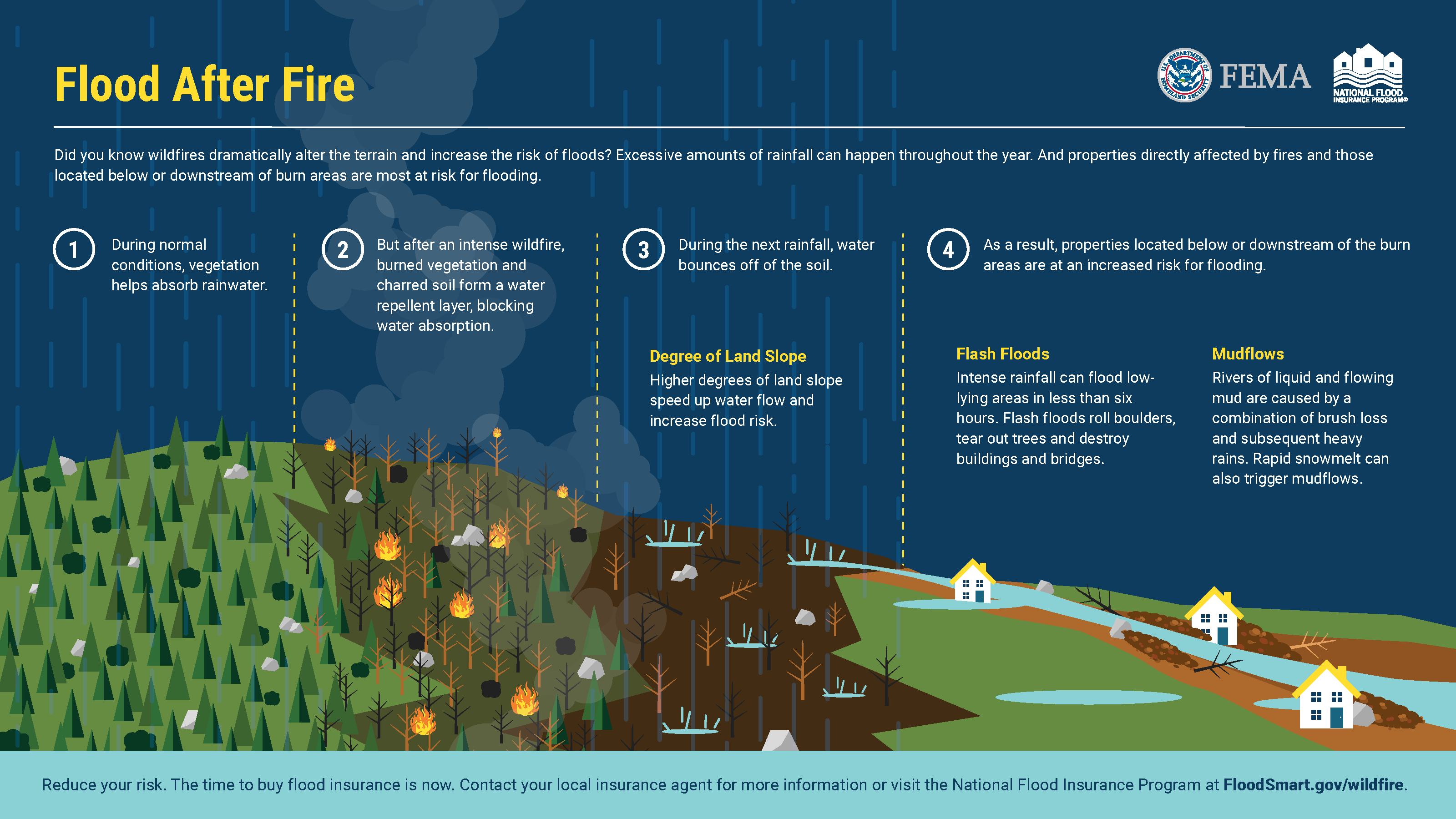Flood After Fire
Flood After Fire Overview
Floods are the most common and costly natural hazard in the nation. While some floods develop over time, flash floods particularly common after wildfires can occur within minutes after the onset of a rainstorm. Even areas that are not traditionally flood-prone are at risk, due to changes to the landscape caused by fire. Residents need to protect their homes and assets with flood insurance now before a weather event occurs and it's too late.
People are at greater risk of flooding due to recent wildfires that burned in their area. Flood risk remains a significant risk for up to five years after a wildfire.
Reduce your risk and the risk of your community by sharing Flood after the Fire messaging from FEMA and the National Flood Insurance Program. The most important messages are:
- Buy Flood Insurance Today. Only Flood Insurance Covers Flood Damage. Most standard homeowner's policies do not cover flood damage. Flood insurance is affordable. An average flood policy costs around $600 a year, rates start at just $129 a year for homes in moderate- to low-risk areas
- The Time to Prepare is Now. Gather supplies in case of a storm, strengthen your home against damage, and review your insurance coverages. No flood insurance? Remember: it typically takes 30 days for a new flood insurance policy to go into effect, so get your policy now.
- Plan Ahead. Plan evacuation routes. Keep important papers in a safe, waterproof place. Conduct a home inventory, itemize and take pictures of possessions.
Use the communication resources below to prepare for Flood after the Fire

Accessible version of the above image text content
Flood After Fire: did you know wildfires dramatically alter the terrain and increase the risk of floods? Excessive amounts of rainfall can happen throughout the year. And properties directly affected by fires and those located below or downstream of burn areas are most at risk for flooding.
- During normal conditions, vegetation helps absorb rainwater
- But after an intense wildfire, burned vegetation and charred soil form a water repellent layer, blocking water absorption
- During the next rainfall, water bounces off of the soil.
- Degree of Land Slope: higher degrees of land slope speed up water flow and increase flood risk
- As a result, properties located below or downstream of the burn areas are at an increased risk for flooding.
- Flash Floods: intense rainfall can flood low-lying areas in less than six hours. Flash floods roll boulders, tear out trees and destroy buildings and bridges
- Mudflows: rivers of liquid and flowing mud are caused by a combination of brush loss and subsequent heavy rains. Rapid snowmelt can also trigger mudflows
Reduce your risk. The time to buy flood insurance is now. Contact your local insurance agent for more information or visit the National Flood Insurance Program at FloodSmart.gov/wildfire.
- Flood After the Fire Resources Communication Resources
- Flood After the Fire Communications Toolkit from Floodsmart for Insurance Agents
- Floodsmart.gov Website
- Flood After the Fire Message Campaign from Floodsmart
- NFIP: What to do before a flood
- FEMA's Flood Insurance Webpage
- FEMA Flood After the Fire Toolkit
- National Weather Service (NWS) Post Wildfire Flash Flood and Debris Flow Guide
- NWS: Burn Scars Have an Increased Risk of Flash Flooding and Debris Flow
- Ready.gov Floods Information
- Ready.gov Flood Safety Social Media Toolkit
- Colorado Information Resources
- Colorado Flood Threat Bulletin
- NWS Forecast Offices in Colorado: Boulder, Pueblo, Grand Junction, Goodland
- Rocky Mountain Insurance Information Association
- READYColorado: Twitter.com/readycolorado, Facebook.com/readycolorado, Website
- COEmergency: Twitter.com/COEmergency, Facebook.com/COEmergency
- Eagle County's Grizzly Creek Fire Basin Debris Flow Google Map
- Other Resources